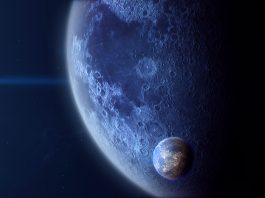The Indian space mission Chandrayaan-3 has gone down in history after becoming the first spacecraft to land on the Moon’s south pole today.
Chandrayaan-3 launched from the Satish Dhawan Space Centre in Sriharikota Range, India, on 14 July. The launch aimed to demonstrate new technologies and achieve India’s first soft landing on another celestial body.
The spacecraft’s Vikram lander successfully touched down as planned this afternoon, allowing India to join the US, China, and Russia (when the Soviet Union) as the only countries to achieve a soft landing on the Moon.
Celebrations have broken out across the country, with Prime Minister Narendra Modi exclaiming “we have reached where no other country could!”
Soft landings on the lunar south pole are extremely difficult
The success of Chandrayaan-3 comes just days after Russia’s Lunar-25 spacecraft span out of control and crashed into the Moon.
Russia’s head of the state-controlled space corporation, Roscosmos, attributed the failure to a lack of expertise due to the long break in lunar research.
Another Indian space mission, which attempted to soft-land in 2019, was unsuccessful. Its lander and rover were destroyed; however, its orbiter survived.
These crashes put the spotlight on how difficult it is to land in the Moon’s south pole region, where the surface is uneven and rocky.
This was vital, as if too much force was applied, the lander would have toppled. Too little force would have meant it could have hit the lunar surface at the wrong place.
Therefore, tense moments preceded the historic touchdown of Chandrayaan-3. However, the lander was controlled to operate at a reduced speed on touchdown – enabling it to make a historic soft landing that other spacecraft had previously failed to do.
What can Chandrayaan-3 tell us about the Moon?
The Indian moon mission is carrying five important instruments that will help reveal the physical characteristics of the Moon’s surface.
It will also study the atmosphere close to the surface and the tectonic activity to study what goes on below the surface.
Carla Filotico, a partner and managing director at SpaceTec Partners, explained: “The historical landing of Chandrayaan-3 is very important for cumulative data and science on the geology of the Moon.”
What’s next for the Indian space mission?
A rover called Pragyaan is set to emerge from Chandrayaan-3 and roam around the Moon’s surface for two weeks. This has been designed to take pictures, conduct experiments on the geology and origins and investigate the presence of water ice on the Moon.
If found in significant quantities, water ice could allow future crew missions to set up base there as it could be used to extract oxygen and fuel.
The European Space Agency (ESA) will also play a fundamental role in supporting the mission as it roams the surface.
ESA stations will relay telemetry and scientific data gathered by Chandrayaan-3’s rover and lander module until it ceases operations.
Rolf Densing, Director of Operations at ESA’s ESOC mission operations centre, said: “The ESA is proud to support the Chandrayaan-3 exploration mission.
“Our ground stations are a core element of ESA’s support to its international partners, and I am pleased that with this activity, we are further strengthening ESA’s relationship with ISRO and with India.”









